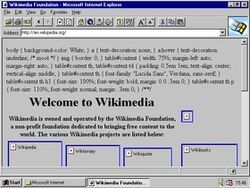Microsoft Internet Explorer 2 (abbreviated as IE2) is a graphical web browser released on November 22, 1995 by Microsoft for Windows 95 and Windows NT and in April 1996 for Apple Macintosh and Windows 3.1.
Version 2 launched with twelve languages including English but this expanded to 24 for Windows 95, 20 for Windows 3.1, and 9 for the Macintosh by April 1996. It lacked many features that became common in later IE versions, including the Blue 'e' logo, integration with Windows Explorer, and bundled programs. Its market share was also much lower than later versions. During its tenure, IE market share only went up to about roughly 3-9% by mid 1996, before IE3 came out.
Internet Explorer 2 is no longer available for download from Microsoft. However, the archive 32-bit version is publicly available on the Evolt.org browser archive.
History[]
IE replicated many of the quirks of Netscape Navigator, and allowed importing bookmarks from it. In May 1996 FTP Software announced it was providing Microsoft with various technology for Internet Explorer 2.0 for Windows 3.1, including a PPP network, 16-bit email client, and other technology.
Availability[]
Internet Explorer version 2 was released in beta in October 1995, only 2 months after version 1 came out in Microsoft Plus! for 95 that August. It was released for Windows 95 and Windows NT 3.5 in November 1995 and was bundled with NT 4.0 in July 1996. The Beta for Mac on PowerPC came out in January, and the finalized version in April for 68k and PowerPC. Version 2 was also the first release for Windows 3.1 and Macintosh System 7.0.1(PPC or 68k), although the Mac version was not released until January 1996 for PPC, and April for 68k.[1] Version 2 was included in Windows 95 OEM Service Release (OSR 1) and Microsoft's Internet Starter Kit for Windows 95 in early 1996. It launched with twelve languages including English but this expanded to 24, 20, and 9 for Win 95, Win 3.1 and Mac respectively by April 1996. The 2.0i version supported double-byte character-sets for supporting Japanese, Korean, Polish or Russian characters in web pages. Version 2.1 for the Mac came out in August 1996, the same month version 2 for Windows was superseded by Microsoft Internet Explorer 3, which was heavily changed from version 2. There were 16-bit and 32-bit versions depending on the OS.
Mac version[]
The Mac version, especially version 2.1, was praised for being economic with resources and for new features. Internet Explorer supported the embedding of a number of multimedia formats into web pages, including AVI and QuickTime formatted video and AIFF, Midi and WAV formatted audio.The non-beta final version was released three months later on April 23, 1996. Version 2.1 fixed bugs and improving stability, but also added a few features such as support for the NPAPI (the first version of Internet Explorer on any platform to do so) and support for QuickTime VR. AOL 3.0 for Macintosh used the IE 2.1 rendering engine in its built-in web browser. The various 16 and 32 bit versions largely depended on the OS although Windows NT would use the 16 bit versions for Windows 3.1
Netscape has enjoyed a virtual monopoly of the browser market (about 90% according to some estimates), and this has allowed it to consolidate its position still further by introducing unofficial or 'extended' HTML tags. As a result, the Web is littered with pages that only work effectively if viewed in Navigator. By the time other browsers catch up, Netscape has made even more additions. —Jack Weber, MacUser 1996
Features[]
IE2 introduced new or improved features for its time period. Many soon became ubiquitous (such as cookies) while other features became obsolete.
- Secure Socket Layer (SSL) protocol
- HTTP cookies
- Virtual Reality Modeling Language (VRML)
- integrated email and news client
- SMTP and POP support
- Newsgroups (NNTP)
- spell checker
- automatic mail management (filter)
- MIME
- MAP
- JavaScript support
- HTML3
- HTML tables
- HTML Frames element support
- nonstandard-tags as background-sounds (bgsound), text-font-tag
- RSA
- PPP network stack
- through Object Linking and Embedding-technologie support for Drag-and-drop
- Bookmark-importer for Netscape.
See also[]
| This page uses Creative Commons Licensed content from Wikipedia (view authors). |

